Bucatini all’Amatriciana
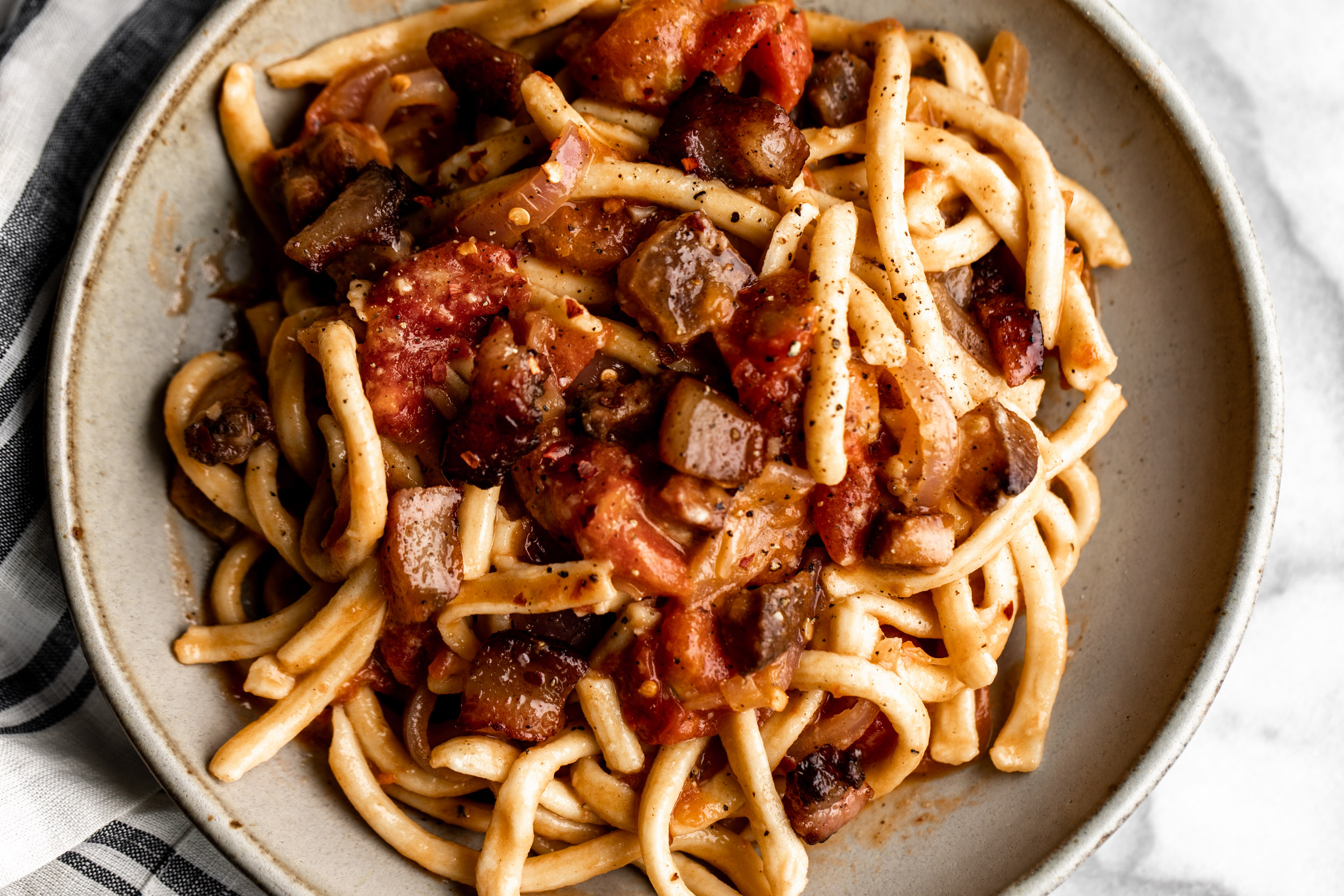
jump toRECIPE
This classic Italian dish is great for weeknight dinners with the quick-cooked tomato-based sauce flavored by the rendered fat of the guanciale, sautéed red onions, black pepper, red pepper and the sharp flavor of Pecorino Romano. The sauce for this pasta is made in one pot so there’s minimal cleanup (a definite bonus in my house)!
Bucatini all’Amatriciana
Table of contents
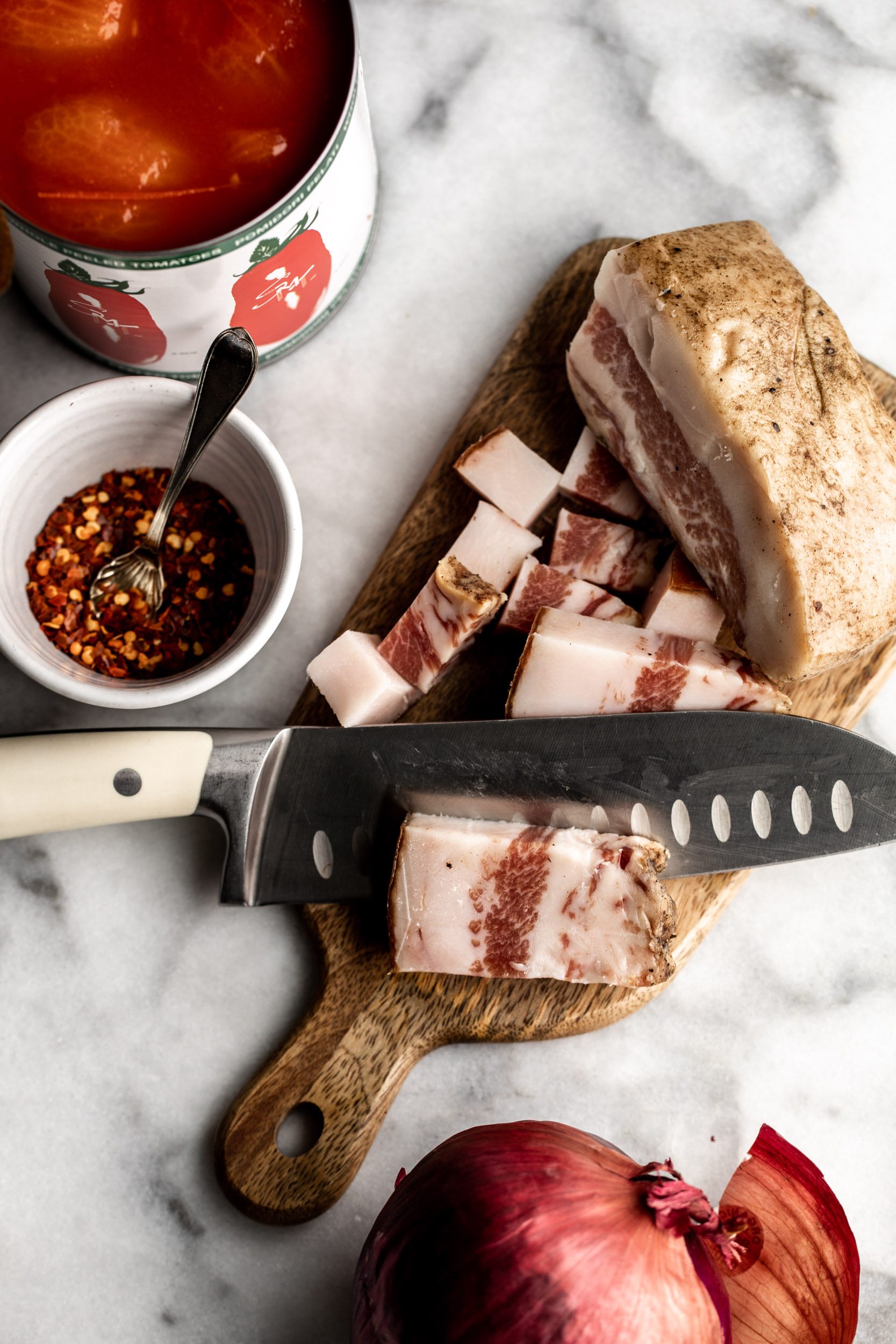
What sets this Bucatini all’Amatriciana recipe apart?
While onions are not considered traditional in bucatini all’amatriciana I love the slightly sweet flavor it adds to the quick-cooked sauce. This recipe is based on my favorite iteration of a dish that I’ve had at the Santa Monica restaurant, Ouovo. The addition of starchy pasta water makes for a glossy and almost creamy pasta sauce.
I like buying a big chunk of guanciale and cutting it into lardons (strips of fatty cured pork) myself so that I can control the size. I prefer larger pieces of the cured pork jowl. When the fat is rendered and the pieces are crispy you still get a bit of tender fat in each bite. If you prefer less fatty pork, I’d recommend cutting it into smaller pieces.
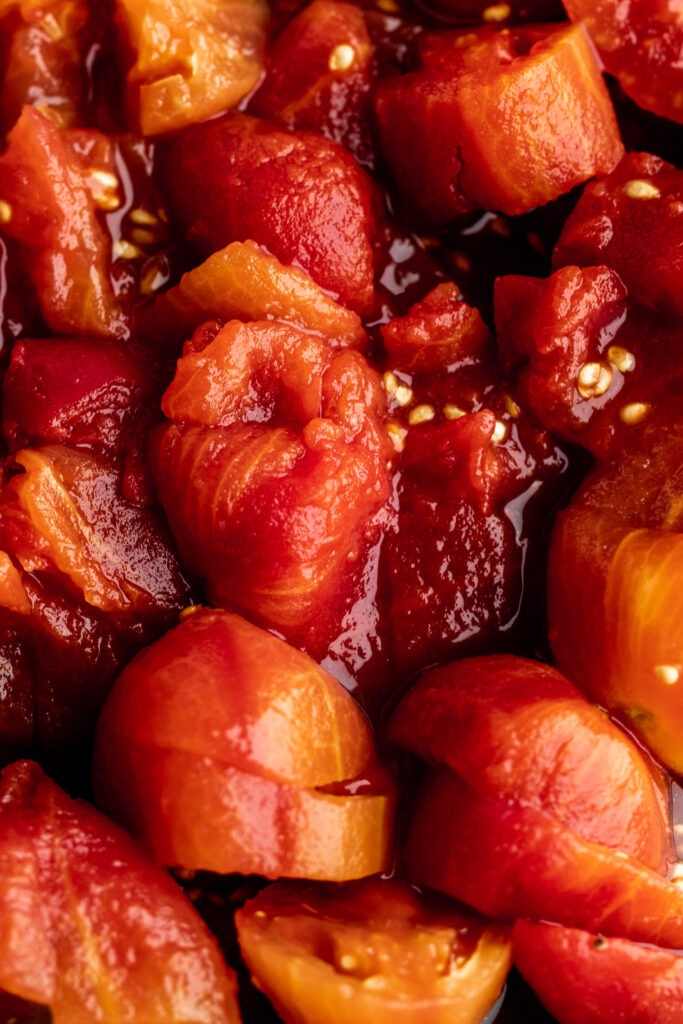
How is guiancale different from pancetta?
Guiancale is cured pork with a high percentage of fat that comes from pig jowls, seasoned with salt, pepper, sage, rosemary and garlic. Pancetta comes from pork belly and is salted, seasoned, cured and aged for an extended period of time. Pancetta is more similar to bacon while guanciale has a flavor all it’s own, however, if you’re looking for a substitute pancetta or bacon will do in a pinch.
What’s so great about bucatini?
Bucatini is in my top 5 pasta shapes. I love how the sauce gets stuck in the hole in the center of the long thick noodles, but if you can’t find it, you can easily substitute spaghetti or linguine. Bucatini is thicker than spaghetti with a hole in the middle. It’s basically the shape of a pool noodle and is great for soaking up sauces, especially velvety sauces like this one, cacio e pepe or this bucatini carbonara with bacon and peas.

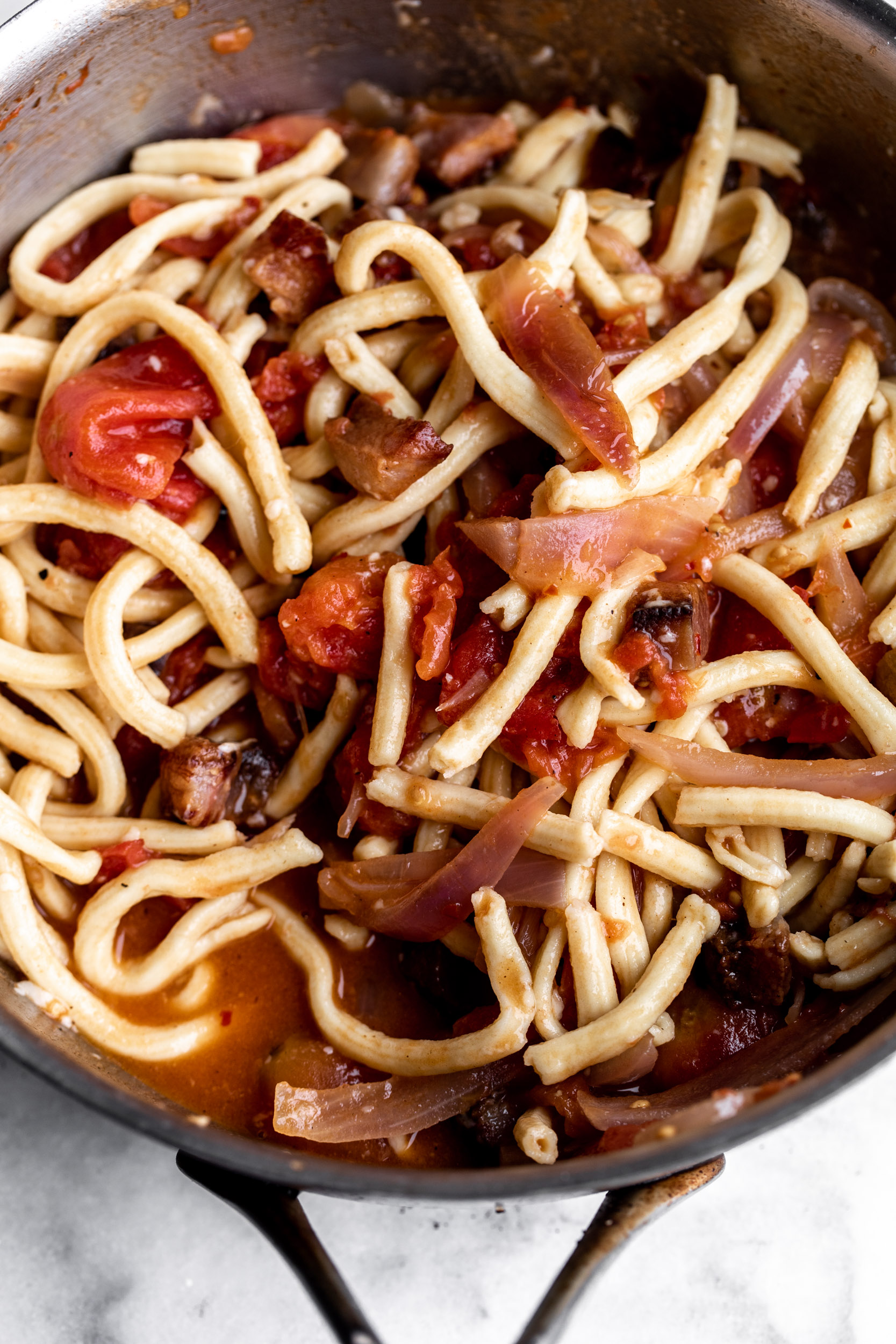
How to make bucatini all’amatriciana
- Step 1: Fry the guiancale until it’s crispy and the fat renders.
- Step 2: Add the onions and sauté then add the wine to de-glaze the pan and simmer until almost evaporated.
- Step 3: Drain and roughly chop the tomatoes then add to the pan and bring to a simmer. Stir in the crispy, cooked guanciale, black pepper and red pepper flakes.
- Step 4: Bring a large pot of salted water to a boil.
- Step 5: Add the pasta and cook, stirring occasionally, until just al dente, about 7 minutes. Set aside 1½ cups of the pasta water then drain.
- Step 6: Add the pasta to the pan with the tomato mixture and toss with some of the pasta water.
- Step 7: Remove from the heat stirring the noodles then slowly add the pecorino, continuing to toss the pasta to combine. Season to taste with salt and serve immediately topped with additional cheese.
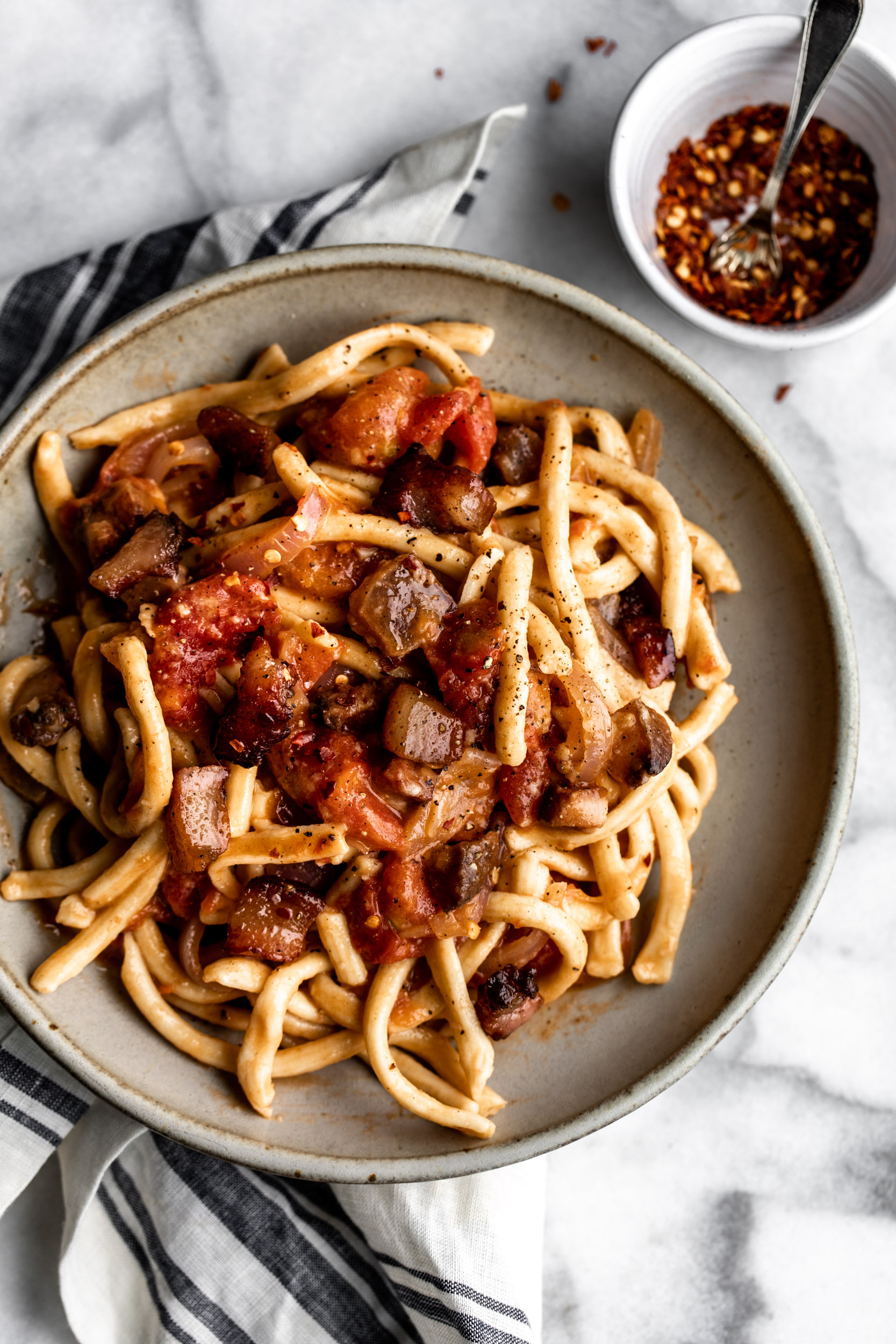
FAQ – Frequently Asked Questions
What if I can’t find guiancale?
If you can’t find guiancale you can substitute lardons of bacon or pancetta. I’d recommend looking at Italian markets or asking at your deli counter.
Are onions traditional?
No but I love the texture and slight sweetness they add to this bucatini all’amatriciana recipe!
Why do you add pasta water to sauce?
The salty, starchy water that the pasta is cooked in adds flavor but also makes the sauce rich and silky. It helps to bind the sauce to the pasta.
Should I add oil to my pasta water before I add the pasta and cook?
No, I don’t recommend it! You want this sauce to bind to the noodles – this is aided by the addition of the pasta water. Adding oil when cooking the noodles will make them slippery and the sauce won’t stick as well.
What does bucatini all’amatriciana mean?
Bucatini all’amatriciana or bucatini amatriciana refers to the spicy pasta sauce made up of pork cheek (guiancale), tomatoes, cheese and in some variations, onions. It’s named for Amatrice, a small Italian town outside Rome.
What if I can’t find bucatini?
I know there’s currently a bucatini shortage so it can be harder to track down dried bucatini. I make my own using my KitchenAid pasta maker attachment for my stand mixer though you can also substitute a similar noodle like spaghetti or a flat noodle like linguine.

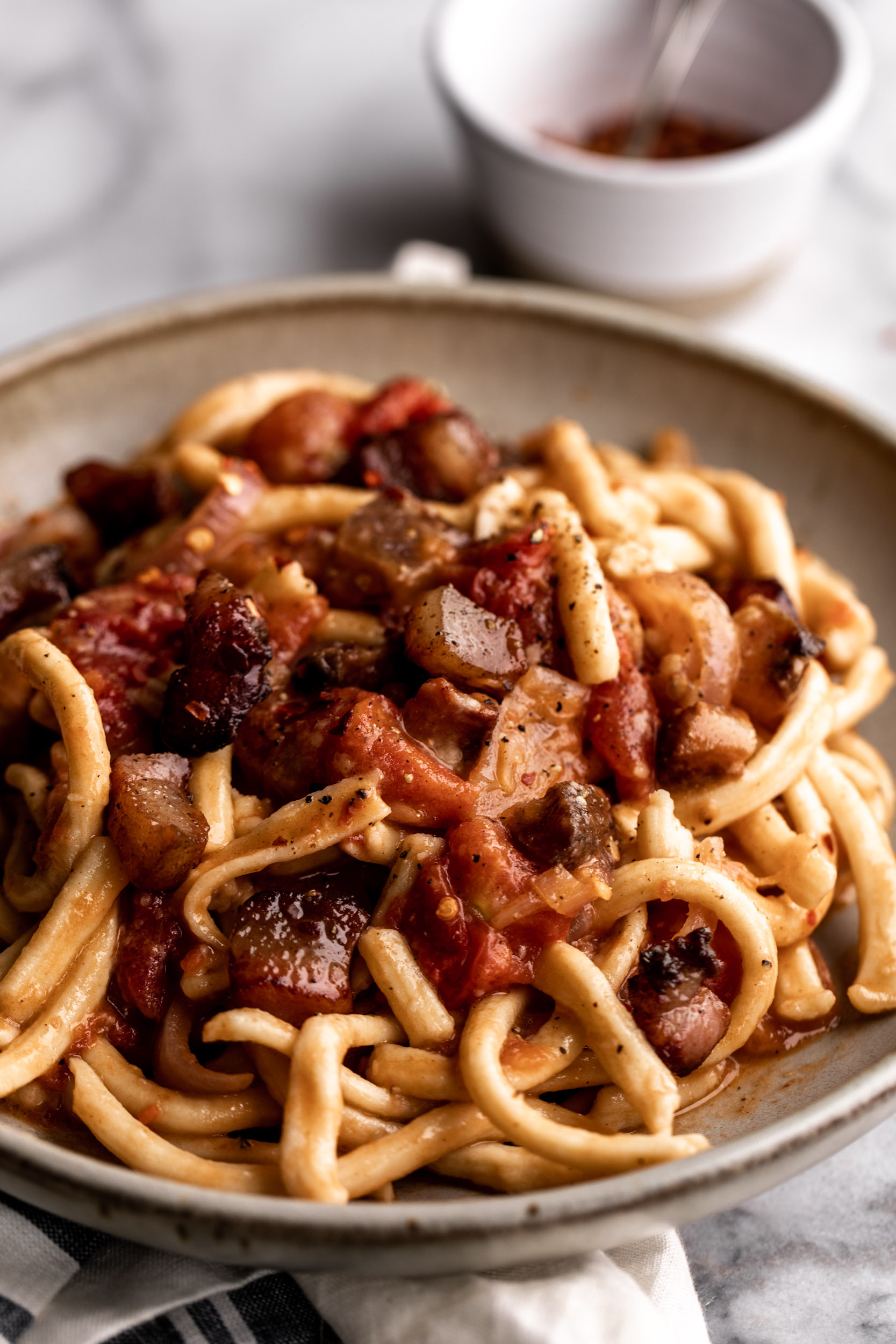
Bucatini all’Amatriciana
Ingredients:
- 2 tablespoons extra-virgin olive oil
- 8 ounces guanciale, cut into ½“ lardons
- 1 small red onion, thinly sliced
- ½ cup dry white wine
- 1 (28-ounce) can whole peeled tomatoes
- 1 teaspoon freshly ground black pepper
- ½ teaspoon crushed red pepper flakes
- ¾ pound dried bucatini
- 1 cup grated pecorino romano, plus additional for serving
Instructions:
- Heat a large sauté pan over medium-low heat, add the olive oil and heat through. Add the guanciale and fry until the fat renders and the lardons are crispy, about 10 minutes. Remove with a slotted spoon, reserving as much fat in the pan.
- Return the pan to medium heat, add the onion and sauté until 6 minutes. Add the wine and cook, scraping any browned bits off the bottom, until the wine has almost completely evaporated, about 6 minutes.
- Drain and roughly chop the tomatoes then add to the pan and bring to a simmer. Stir in the cooked guanciale, black pepper and red pepper flakes.
- Bring a large pot of water to the boil; add the salt and bring back to the boil. Add the bucatini and cook, stirring occasionally, until just al dente, about 7 minutes. Set aside 1½ cups of the pasta water then drain.
- Add the pasta to the pan, using tongs to toss to combine with ½ cup of the pasta water. Heat over high heat and toss the pasta rapidly until the sauce thickens and coats the noodles, adding more pasta water if the sauce gets too thick.
- Remove from the heat then slowly add the pecorino, continuing to toss the pasta to combine. Season to taste with salt and serve immediately topped with additional cheese.
DID YOU MAKE THIS?
TAG ME ON INSTAGRAM TO BE FEATURED ON MY STORIES! @cookingwithcocktailrings
This page may contain affiliate links. If you choose to purchase after clicking a link, I may receive a commission at no extra cost to you. Thank you for your support so I can continue to share recipes with you!

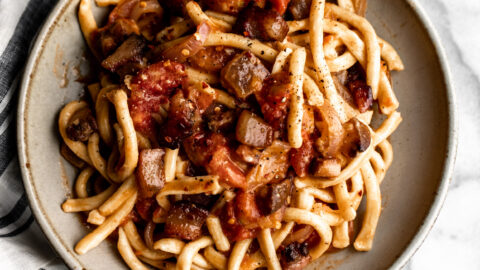
)
)

Used pancetta instead of guanciale and sauce still came out delicious! My new go-to all’amatriciana sauce recipe!
So happy to hear it Erin! xx